A Collectivist Wonderland On Ice
Writer and Art Shanty Projects tour guide extraordinaire Andy Sturdevant gives a funny, informative inside look at the wacky, ingenious offerings to be found in the ice house community that's taken shape in Plymouth this year
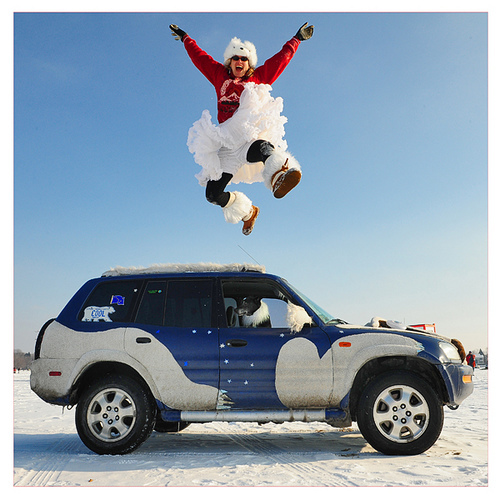

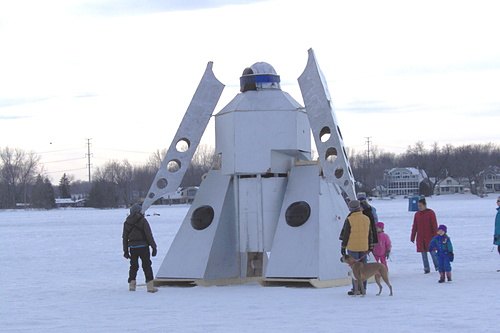

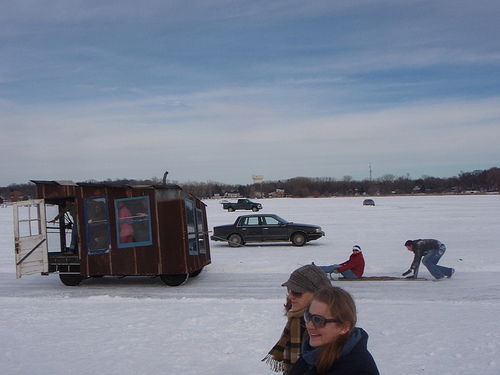
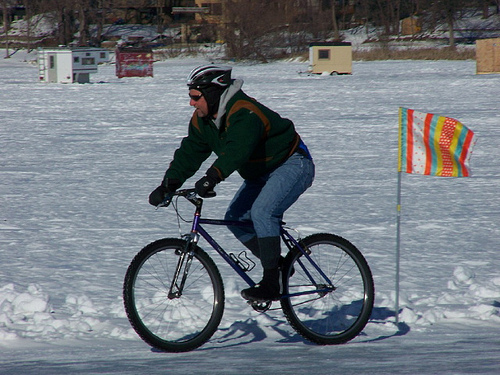
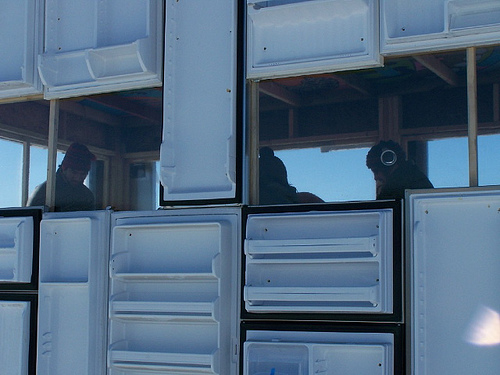

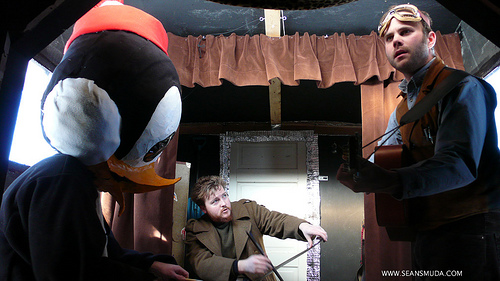
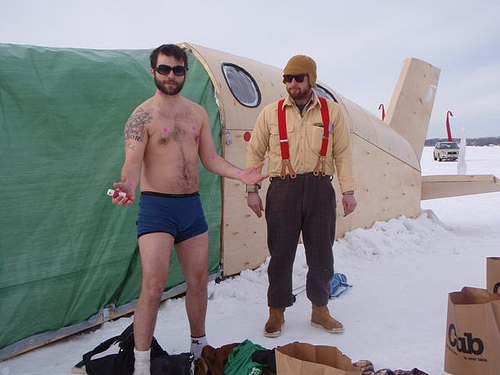
Not a glamorous lake
Medicine Lake is not a glamorous lake. It’s a large lake, but it’s not a glamorous lake. By most objective criteria, it doesn’t compare favorably to its metro-area neighbors Minnetonka to the west, the Chain of Lakes to the east. Medicine Lake does not have beautiful summer houses, and it does not have paddleboats. It does not have sexy Vikings houseboat parties. There are no picture postcard views of downtown Minneapolis twinkling in the distance, and there are few sepia-toned collective memories of frolicking lakeside Victorians in hoop dresses and straw boaters. There are no secret beaches for curfew-breaking urban teenagers to skinny dip in (that I know of, anyway), and there are cleansing waters. Truth be told, it’s not even one of the better fishing lakes – there aren’t even any muskies! If one looks at the qualities which make a Minnesota lake the stuff of legend, one doesn’t find much to goose Medicine Lake into that top tier. Sure, it’s pleasant. But Wobegon it ain’t.
I asked Peter Haakon Thompson, the co-founder of the Art Shanty Projects, why he chose Medicine Lake for the site in the first place. His answer was simple and homey: Thompson grew up on the north end of the lake, and he knew the area well. It was accessible from the city, but it was far out enough to be a destination. One of the urban lakes like Calhoun or Harriet would have been too easy for jaded hipster artists to reach simply by stumbling out of their Uptown apartments, plus the city doesn’t allow overnight structures to be built on those lakes, anyway. A lake like Minnetonka was perhaps too far out, and already a known cultural quantity (see sexy Vikings houseboats, above). So, you return to what you know. Even putting aside such practical considerations as distance, size, and accessibility, Medicine Lake is conceptually perfect. It has a weird enough secret history to be perfectly suited for something like ASP – I would here refer you to one of my weekend history tours so you can hear the whole story. And then there’s that shape. That shape which has graced t-shirts and buttons and posters. Just look at it.
It’s surely as iconic as such great Minnesota symbols as Prince’s red and white plow on the Snow Emergency signs. Admire the graceful outcroppings, the vaguely pinchy anthropomorphism of that southwestern branch, the understated westward tilt. Sometimes you just get really lucky shape-wise, with a kick-ass birthmark or a Virgin Mary on your morning toast, and this is certainly one of those times. Minnetonka is sprawling and shapeless, and Calhoun and Harriet are pinched little blobs, but Medicine Lake is a looker.
So, consider this a cursory overview of some of the shanties that are out there in this, the fifth year of ASP. I’m not going to group them geographically, it would be more fun for you to figure that part out on your own. Rather, I’d like to point out a few recurring motifs to the entries for this year; as you plan your daytrip out to Medicine Lake, I suggest that it might be interesting to experience Shantyville in thematic chunks. The wonderful thing about the shanty projects is that, in its fifth year, little concerns like “quality of construction” have finally caught up with the conceptual concerns. Everyone that’s out there knows how to build a shanty at least as well as (or better!) than your retired uncle in Thief River Falls, so they’re almost all uniformly well-heated, comfortable, and tidy. Ice shanties, after all, are by their very nature built to accommodate long, meandering afternoons, and the success of this year’s ASP is that each shanty welcomes as in-depth an experience as you want to have.
The old standbys
Four structures form the heart of Shantyville. It’s our National Mall, our Lower Manhattan, Southdale to ASP’s Edina. As such, it’s the best place to get a sense for what the ASP is and how it has come to be. In the beginning was Peter Thompson’s Autoethnographic Headquarters, the very first art shanty, and it has been at the heart of ASP for all five years. Inside, one gets a sense for the original goal of the project – it’s warm, it’s well-made, it’s attractive with its metal and wood construction. You can pick up souvenirs and check in on the weather, or talk to Peter himself. I have, myself, watched the man answer questions as disparate as “do you feel the shanty project is somehow a reflection of emerging collectivist trends in contemporary art?” to “is it cool if I pee on the ice?” with the quick wit and panache of an old icehouse pro. ASP co-founder David Pitman’s K-ICE Studios occupies a similarly iconic spot. Broadcasting random messages, music, public service announcements, monologues, and sound effects on a low-end FM frequency (97.7!) from the middle of a lake, into the dead of winter for anyone to hear, is exactly the sort of strangely populist, yet essentially solitary, undertaking that makes ASP so appealing. K-ICE’s broadcasts are like hallucinatory reconfigurations of stately, old Gary Eichten’s MPR chestnut Midday, shot through with mid-century Mexican pirate radio and 1970s-era performance art. The Postal Shanty is also emblematic of the sort of low- to medium-technology communication that the project facilitates: you can communicate with anyone on the ice simply by knowing what shanty they’re occupying and putting an item in the regular postal mail for hand delivery. Communication of a more communal kind occurs daily at the Norae Shanty, perhaps the most beloved of all the projects out on the ice. Mike Hoyt brings disparate groups of strangers into his shanty for marathon karaoke sessions with the best book around, a constant ebb and flow of people coming and going and singing Smiths songs to each other. The walls are covered with past requests, forming a documentary history of the various musical desires of the ASP community. Streetlights, people! Dont stop believing!
Dystopian futures
Maybe it’s the upcoming recession, the endless warnings of global pandemic, terror and climate meltdown, or just the exhaustion of eight years of spectacularly dysfunctional governance. Whatever it is, there’s a pretty healthy undertow of blistering dystopia in Shantyville in this final year of the Bush administration. There’s no better place to take an afternoon to celebrate the imminent collapse of Western civilization than on the windswept, subzero environs of Medicine Lake in February. The Ice Cubicle stands as a relic of a snow Rapture, an empty office set with a drawing rack full of wind-battered papers and a computer monitor that has frozen over. A few hundred cold and windy yards north of the cubicle is the site of the S.U.R.V.I.V.A.L. project, the skeletal remains of a downed aircraft transporting a documentary film crew, who, unlike the absentee inhabitants of the cubicle, are clinging to life in a narrative that is playing out over the course of ASP. The white, empty landscape behind them adds credibility to the story; anyone who was out on the lake the first weekend of ASP for the -30° wind chill temperatures knows that the barrier between mere physical discomfort and actual physical danger is much thinner than we often acknowledge. (The tarp-covered interior is extraordinarily warm, though, so don’t let that stop you from entering). The specter of desertion and abandonment hangs over the Abandoned Antarctic Shanty, as well. Based on an actually abandoned Argentinean research outpost, it is filled with the detritus of everyday life, objects that visitors to the site have left behind. And who lords over this frozen post-human hellscape? The Giant Robot, of course! One of the more spectacular feats of engineering in the annals of the Art Shanty Projects, the Giant Robot is completely mobile and spends most afternoons tooling around the ice and flailing its impressively articulated arms.
In transit
What’s the one thing you brag to your San Francisco and Portland friends about regarding Minneapolis? Besides the number of theater seats? That’s right, the biking culture. Well, it continues on the ice, too. Each weekend of ASP you’ll see a number of cyclists speeding down the bicycle course that has been smoothed out over the top of the lake. These weekend races are headquartered out of the nearby Bicicle Shanty, a plastic white marvel built solely from refrigerator doors; it looks like something from 2001: A Space Odyssey. Cycling power will also get you far in the Mobile Home Shanty, a moving shanty on wheels, fired by Minneapolis cycling love and human sweat. The construction of this one is particularly clever – the building seems to lean back as it scoots, foot-powered, across the landscape, complete with a chimney piping out actual steam. If, upon seeing these marvels of wintertime cycling ingenuity, you want to try your own hand at building something, Paul Linden in the Woodworking Shanty can help you get set up. A temple to Minnesota know-how, Linden’s shanty has been offering, among other things, informal workshops in creating the sort of metal-studded bicycle snow tires that get you across the ice on two wheels and in one piece. Of course, if six or eight cylinders are more your style, you can always see the festivities on the lake from the seat of one of the Art Car Taxi Warming Shanty’s fleet of art cars. Their yellow-checkered way station has hot dogs and other grilled goodies for sale, and it’s a hub of activity and friendly conversation. As anyone who has spent time on the lake will tell you, if you’re not going to be inside, then it’s best to keep moving. That’s the joy of ASP: all the personal hubbub and commotion outdoors, in the middle of the bleakest, most inactive and isolated time of the year, but it’s also the best way to stay warm.
An afternoon in the cultural district
There’s a great love on the ice this year for complex acronyms and equally complex thematic back-stories, most of which find their truest expressions in the ASP’s de facto cultural district. IAMER (Institute for the Advancement of Metatemporal Education and Research) and their Field Museum have been established by two highly-credentialed time-traveling research scientists from the far future to tell the story of the cultural customs and habits of the 21st century Midwestern American human. On the other end of the temporal spectrum is my own shanty that I run with Lesley Kadish, the MOWSAR (Mysterious Order of the Western School for Anthropoglacial Research) Lodge a shambling, deteriorating 1930s-era shanty devoted to telling the story of how Medicine Lakers lived in the past (and also devoted to avoiding an imminent foreclosure). Speaking of deterioration, the nonprofit Ice Preservation Fund operates an Ice Museum, which houses an impressive collection of ice specimens from all over the world, and which has been established to educate the public on matters related to ice – specifically, the loss of so much ice owing to climate change. It’s a smart shanty designed with a nod to neoclassical civic architecture that still looks, well, like a ramshackle Medicine Lake ice house. The Limnology Shanty operates a museum devoted to the study of the science and biology of the lake that sits underneath the ice, and –phew!– when you’ve had enough sociology, culture and science for the day, there’s the Black Box Theater, which is running a full schedule of theater, puppeteering, music, dance, and arts programming. Their schedule is actually more ambitious than some landlocked arts organizations, a credit to that great and enduring local cliché regarding our abundance of theater seats per capita.
Now it’s your turn
So you’ve followed this schedule, perhaps, and have spent a few afternoons riding balloon-wheeled ice bicycles, learning about microscopic underwater life, seeing a dance production, and singing a rip-roaring version of “The Killing Moon” to a new-wave art cutie bundled in a down jacket. You’ve huddled into the wreckage of a downed aircraft thinking about your favorite scenes from Alive. Probably you’ve also discovered a great many shanties not even covered in this guide. Fun, indeed, but perhaps now, after all you’ve seen, you’ll be as inspired as the wild-eyed lady I saw in a multiple shanties last weekend; she bragged about how, next year, she’d be putting in a proposal for a shanty. If you find yourself with an urge to create, you may wish to begin making your shanty design plans for next year in one of the most welcoming shanties in ASP, the Medicine Lake Drawing Club. A structure covered in chalkboard paint and full of paper and pencils and high-concept whimsy, the MLDC runs a full program of drawing-related activities – a particular crowd-pleaser so far has been the portrait-fencing competitions, which pits two sketch artists against each other, armed only with skewer-like pencil-extenders. There are mobiles to be made in the Mobile Shanty (Mobiles! Like Alexander Calder! Not to be confused with the Mobile Home Shanty!); there’s knitting in the Knotty Knitters Knitting Shanty, and there are all manner of crafts and creative endeavors in store for you in the Shanty of Misfit Toys (perhaps the most kid-friendly offering out there). There are some good opportunities to participate in photography projects, as well. The Pinhole Shanty is a free-standing camera that acts as a self-contained darkroom, and takes photos that reflect, with an appropriately old-timey sense of silent eeriness, the environs of the lake in all its black-and-white glory. The final interactive document of your visit should be the Snap Shot Shanty, whose ongoing mission is to capture the image of every ASP visitor in their on-ice studio. The results, posted on their website, are an impressive catalog of the vagaries of Minnesota winter fashion, from pink tights, oversize sunglasses and aviator goggles to Northwoods-chic flannel, full beards, baby carriers and down jackets which un-ironically sport the logos of prominent Minnesota employers. Collectively, this online album serves as a valentine to the wonderfully strange and resilient people that populate this state.
Actually pertaining to fishing
As a participant in the shanty projects, I feel fairly well-prepared for any question that is asked of me by visitors. Only one question, really, manages to jar me: a visitor steps inside, looks around, scratches his or her head, and asks, “Er, where do you fish out of?” Oh my god! Good question! In all the ambulatory robotics, primitive camera technology, woodworking and lectures, you might forget that the sole basis for a shanty, traditionally, is to be a structure that people use for fishing. Thankfully, at least two shanties haven’t forgotten the roots of the project: The Big Fish Eating Ice House is reminiscent of a trawling boat with a series of elaborate nets in the front, though the typical order is reversed: once inside, the shanty is constructed to seem as if you the visitor has been swallowed up whole into the bowels of one the lake’s much sought after northern pikes or walleyes. The Medicine Lake Fishery is a two-story testament to solid architectural practices and recreational angling, and, fittingly, is the tallest structure on the ice. It’s the first thing you see from shore and the last as you drive back out onto 169.
Taken all together, the ASP has always been, for me, the perfect microcosm of the Minnesota of legend – not the bogus, repressed Lutheran Siberia our state is often made out to be, but rather a weird, collectivist wonderland of hard work, strange humor, community and goodwill, of staying warm and having a fine time doing so.
About the author: Andy Sturdevant was born in 1979 in Columbus, Ohio and grew up in Louisville, Kentucky. He graduated from the University of Louisville in 2004 with a BFA in studio art, and moved to Minneapolis shortly thereafter. Andy is a contributor to Minnesota Public Radio’s Electric Arc Radio Show and a guest curator for the Soap Factory’s 2008 season. His writing and artwork have also appeared in The Rake, ARP! and Bejeezus magazines.